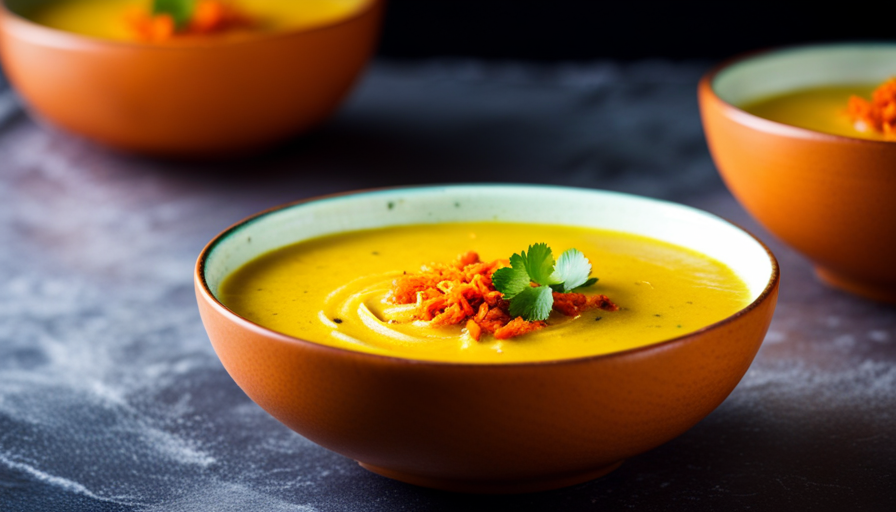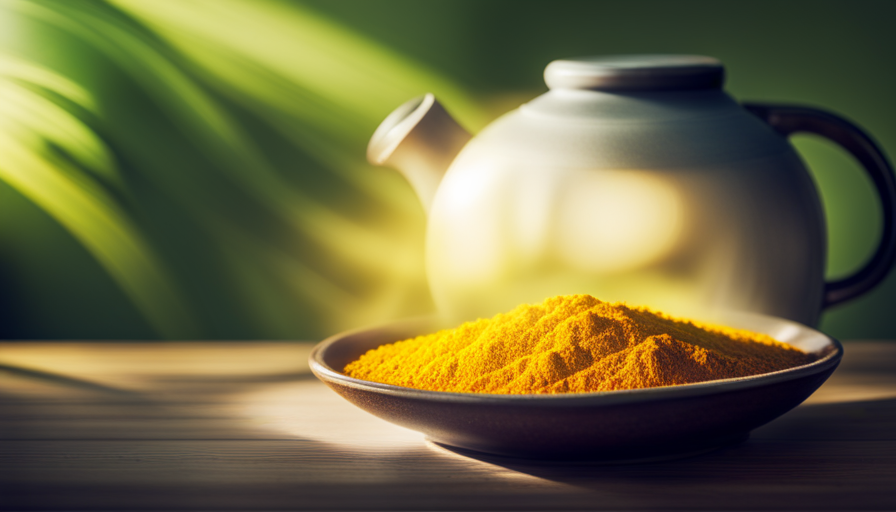In the world of delicious food, there is an ingredient that can take our taste buds on a journey of lively flavors and enticing aromas. Its golden color, like a bright sunrise, represents warmth, energy, and the excitement of a tasty experience.
I’m talking about turmeric, the beloved spice that has found its way into countless kitchens around the world.
When it comes to soups, turmeric adds a touch of magic that elevates the entire experience to new heights. Its earthy and slightly bitter taste, with hints of ginger and citrus, infuses soups with a complexity that is both comforting and invigorating. As it swirls through the simmering broth, turmeric imparts a warmth that soothes the soul and awakens the senses.
But turmeric is not just about flavor. It brings with it a myriad of health benefits, from its potent anti-inflammatory properties to its ability to aid digestion and boost the immune system. And let’s not forget its captivating golden color, which can transform an ordinary soup into a feast for the eyes.
Join me as we delve into the world of turmeric in soup, exploring its diverse flavor pairings, discovering delicious recipes, and unraveling its cultural significance. Get ready to embark on a culinary adventure like no other, where each spoonful of soup becomes a moment of pure bliss.
Key Takeaways
- Turmeric adds warmth, depth, and a slightly bitter taste to soup.
- It pairs well with ingredients like ginger, garlic, cumin, coconut milk, lime, and cilantro.
- Turmeric enhances the taste of other spices and ingredients in soup.
- Turmeric’s vibrant yellow color adds visual appeal to soup.
The Flavor Profile of Turmeric
When you add turmeric to soup, it infuses a warm and slightly earthy flavor that’s reminiscent of ginger and mustard, creating a vibrant and aromatic experience for your taste buds.
Turmeric has a distinct taste that’s both bold and subtle at the same time. It adds a hint of bitterness, but it’s also slightly sweet with a subtle spiciness. This unique flavor profile comes from the compound called curcumin, which’s responsible for many of turmeric’s health benefits.
Turmeric not only brings a delightful taste to soup but also offers numerous health benefits. It’s known for its anti-inflammatory properties and is often used in traditional medicine for its healing properties. Incorporating turmeric into your soup can be a great way to boost your immune system and support overall wellness.
When it comes to flavor combinations, turmeric pairs well with a variety of ingredients. It works beautifully with ingredients like ginger, garlic, and cumin, enhancing their flavors and creating a harmonious blend. Additionally, turmeric goes well with coconut milk, lime, and cilantro, adding a tropical twist to your soup.
By incorporating turmeric into your soup, you not only elevate its taste and aroma but also reap the benefits of this potent spice. It’s time to explore the world of flavors and enhance your soup with the vibrant and aromatic touch of turmeric.
Enhancing Soup Flavors with Turmeric
When it comes to enhancing the flavors of soup, turmeric is a versatile and powerful ingredient. It adds a warm and earthy depth, bringing a unique richness to the broth. It also helps balance out the richness and creaminess of other ingredients, creating a harmonious blend of flavors.
Additionally, turmeric complements and enhances the taste of other spices and ingredients, adding complexity and depth to the overall soup profile.
Adding Warmth and Depth
To really amp up the warmth and depth in your soup, toss in some turmeric – it’s like a cozy hug from grandma’s kitchen. Turmeric adds a rich, earthy flavor that instantly elevates any soup. The warm, slightly bitter undertones of turmeric create a comforting and satisfying taste experience.
But turmeric doesn’t just enhance the flavor; it also brings unique health benefits to your soup. This vibrant yellow spice is known for its anti-inflammatory properties and is packed with antioxidants. So not only does it make your soup taste amazing, but it also boosts your overall wellbeing.
Now, let’s move on to balancing richness and creaminess in your soup, which is the next step in creating a truly delicious and satisfying dish.
Balancing Richness and Creaminess
Achieving the perfect balance between richness and creaminess in your soup is key to creating a truly indulgent and velvety texture. It’s a delicate dance, where the flavors must blend harmoniously to create a satisfying experience for your taste buds.
Balancing flavors is essential, as too much richness can overwhelm the palate, while too much creaminess can dull the overall taste. To achieve this balance, consider adding a touch of acidity, such as a squeeze of lemon juice, to cut through the richness. Additionally, incorporating fresh herbs like parsley or cilantro can add a brightness that complements the richness and creaminess.
Not only does turmeric contribute to the overall balance of flavors, but it also brings an array of health benefits to your soup, such as its anti-inflammatory properties. Transitioning to the next section about complementing other spices and ingredients, it’s important to explore how turmeric interacts with other flavors to create a truly unique and delicious soup.
Complementing Other Spices and Ingredients
Adding a dash of cumin and a sprinkle of paprika can elevate the flavor profile of your dish to new heights. However, when it comes to complementing other spices and ingredients, turmeric stands out as a unique and versatile addition. Its warm, earthy flavor adds depth and complexity to soups, while also enhancing the overall taste.
Turmeric pairs well with a variety of other spices, such as ginger and cinnamon, creating a harmonious blend of flavors. Additionally, turmeric can be used in unexpected ways, like adding a touch of sweetness to desserts or infusing marinades with a vibrant golden hue. Its versatility knows no bounds.
With its ability to complement and enhance, turmeric seamlessly integrates into any soup recipe. It’s time to move on to the next section and explore the health benefits of turmeric in soup.
Health Benefits of Turmeric in Soup
The incredible health benefits of turmeric in soup will leave you feeling amazed. Adding turmeric to your soup not only enhances the flavor but also provides numerous health benefits. Turmeric is known for its anti-inflammatory and antioxidant properties, making it a great addition to any soup. It has been used for centuries in skincare to help reduce inflammation and improve complexion. Additionally, turmeric can be enjoyed in tea to promote overall well-being.
To help you appreciate the health benefits of turmeric in soup, here is a table showcasing its key advantages:
| Health Benefits of Turmeric in Soup |
|---|
| Reduces inflammation |
| Boosts immune system |
| Promotes healthy digestion |
| Supports heart health |
Including turmeric in your soup not only adds a vibrant color but also infuses it with a myriad of health benefits. Its distinct flavor adds depth and warmth to the soup, creating a delicious and nutritious meal. As we move on to the next section about pairing turmeric with different soup types, you’ll discover even more ways to enjoy this incredible spice.
Pairing Turmeric with Different Soup Types
When it comes to pairing turmeric with different types of soup, there are several options that can enhance the flavor and health benefits.
Creamy vegetable soups are a great choice as the earthy taste of turmeric complements the richness of the soup.
Lentil and bean soups also benefit from the addition of turmeric, as it adds a warm and slightly bitter note to the hearty flavors.
Lastly, chicken and noodle soups are elevated by the inclusion of turmeric, as it adds a subtle warmth and depth to the broth.
Creamy Vegetable Soups
Creamy vegetable soups can be enhanced by the warm and earthy taste of turmeric. Adding this vibrant spice can elevate the flavors of the soup, creating a delicious and satisfying dish.
Here are three ways turmeric can transform creamy vegetable soups:
-
Turmeric in creamy pasta: By incorporating turmeric into a creamy pasta soup, you can add depth and richness to the dish. The earthy notes of turmeric complement the creaminess of the pasta, creating a harmonious blend of flavors.
-
Turmeric in potato dishes: Turmeric can also be a wonderful addition to creamy potato soups. Its warm and slightly bitter taste adds complexity to the soup, balancing out the creaminess of the potatoes.
-
Turmeric-infused broth: Another way to incorporate turmeric into creamy vegetable soups is by infusing the broth with this spice. This imparts a subtle, yet distinct, flavor throughout the soup, enhancing the overall taste.
Transitioning to the next section about lentil and bean soups, these hearty options also benefit from the addition of turmeric.
Lentil and Bean Soups
Adding turmeric to lentil and bean soups creates a burst of flavor that takes these hearty options to a whole new level. Turmeric adds a warm, earthy taste to lentil soup, complementing the rich and creamy texture of the lentils. It enhances the natural sweetness of the beans in bean soup, providing a subtle hint of spice that lingers on the palate.
The vibrant yellow color of turmeric also adds visual appeal to these soups, making them even more enticing. When simmered with turmeric, lentils and beans absorb its flavors, creating a harmonious blend that satisfies the taste buds. As the aroma of these soups fills the air, you can’t help but anticipate the comforting flavors that await.
Now, let’s move on to the next section about chicken and noodle soups, where we explore how turmeric can elevate these classic favorites.
Chicken and Noodle Soups
Roasted chicken and velvety noodles dance together in a symphony of flavors, tantalizing the senses with every spoonful. Chicken and noodle soups come in various forms, each with its own unique twist.
From classic chicken noodle soup with tender chunks of chicken and slurp-worthy noodles to Asian-inspired variations infused with fragrant spices, the possibilities are endless.
One such spice commonly used in Asian cuisine is turmeric. This vibrant yellow spice adds a subtle earthy flavor and a beautiful golden hue to the soup. Not only does turmeric enhance the taste, but it also brings health benefits with its anti-inflammatory properties.
As we delve into the next section about turmeric as a natural food coloring, we will discover its versatility beyond just flavoring soups.
Turmeric as a Natural Food Coloring
Turmeric can give your soup a vibrant yellow hue, making it a fun and natural alternative to artificial food coloring. Not only does it add a beautiful color, but it also brings a unique flavor to your dish. Turmeric has a warm and earthy taste with a hint of bitterness and a peppery kick. It adds depth and complexity to any soup, enhancing the overall flavor profile.
In addition to its aesthetic appeal, turmeric also offers several health benefits. It contains a compound called curcumin, which is known for its anti-inflammatory and antioxidant properties. Incorporating turmeric into your soup can help boost your immune system and promote overall well-being. Plus, it’s a great way to add some extra nutrients to your meal.
To help you better understand the benefits of using turmeric as a natural food coloring, here’s a table showcasing some of its key properties:
| Property | Description |
|---|---|
| Color | Vibrant yellow hue |
| Flavor | Warm, earthy, slightly bitter, and peppery |
| Health Benefits | Anti-inflammatory, antioxidant, immune-boosting |
| Nutrients | Vitamins, minerals, and other beneficial compounds |
| Versatility | Suitable for various soup recipes |
Using turmeric in your soup not only adds a pop of color but also enhances the taste and provides numerous health benefits. Now, let’s move on to some tips for using turmeric in soup without overpowering the other flavors.
Tips for Using Turmeric in Soup
One interesting fact about incorporating turmeric into your soup is that it’s been used for centuries in Ayurvedic medicine due to its powerful anti-inflammatory properties, making it a great addition to your diet.
When using turmeric in soup, there are a few tips to keep in mind to ensure the best flavor and results.
First, it’s important to note that turmeric can add a distinct earthy and slightly bitter taste to your soup. However, when used in the right amount, it can enhance the overall flavor profile and provide a beautiful golden hue. If you’re worried about the bitterness, you can balance it out by adding a touch of sweetness or acidity, such as a squeeze of lemon juice or a drizzle of honey.
Another tip is to pair turmeric with complementary flavors. For instance, turmeric pairs well with ginger, garlic, and cumin. These spices work together to create a robust and aromatic base for your soup. Additionally, turmeric can also be used in desserts and marinades, adding a unique twist to your culinary creations.
With these tips in mind, you can now explore the world of turmeric-based soup recipes and discover the incredible flavors and health benefits it has to offer.
Turmeric-Based Soup Recipes
If you’re craving a comforting and flavorful meal, try incorporating turmeric into your soup recipes for a vibrant and healthy twist. Turmeric adds a warm and earthy flavor to soups, making it a versatile ingredient that pairs well with a variety of flavors. One way to use turmeric in soup is by adding it to seafood dishes. The combination of turmeric and seafood creates a delicious and aromatic flavor profile that is both satisfying and unique. Another way to incorporate turmeric is by using it to create a turmeric-infused broth. This broth can serve as a flavorful base for your soup, enhancing the overall taste and providing a nourishing element to your meal. To give you some inspiration, here’s a table with three turmeric-based soup recipes that you can try at home:
| Soup Recipe | Ingredients |
|---|---|
| Turmeric Lentil Soup | – Red lentils, – Vegetable broth, – Turmeric powder, – Onion, – Garlic, – Ginger, – Cumin, – Coriander, – Coconut milk |
| Turmeric Chicken Soup | – Chicken broth, – Chicken breast, – Turmeric powder, – Carrots, – Celery, – Onion, – Garlic, – Fresh parsley |
| Turmeric Vegetable Soup | – Vegetable broth, – Turmeric powder, – Carrots, – Celery, – Onion, – Garlic, – Zucchini, – Bell peppers, – Tomatoes |
These recipes will not only satisfy your taste buds but also provide you with the health benefits of turmeric. Now, let’s explore some turmeric variations and substitutes to further enhance your soup-making experience.
Turmeric Variations and Substitutes
When it comes to turmeric, there are a few variations and substitutes worth exploring. Firstly, there’s turmeric powder versus fresh turmeric. While turmeric powder is more convenient and widely available, fresh turmeric offers a bright and earthy flavor that can elevate any dish.
Secondly, for those who may not enjoy the taste of turmeric or want an alternative, curcumin supplements can be a viable option. They provide the health benefits of turmeric without the distinct taste.
Lastly, blends and mixes with turmeric allow for creative and unique flavor combinations. Whether it’s a curry powder blend or a golden milk mix, these combinations can add depth and complexity to your culinary endeavors.
Turmeric Powder vs. Fresh Turmeric
Turmeric powder or fresh turmeric, both add a distinct earthy flavor to your soup that can transport you to exotic lands with just one taste. The choice between the two depends on personal preference and availability. Here are three reasons why I love using fresh turmeric in my soups:
-
Vibrant Color: Fresh turmeric has a bright orange hue that creates a visually stunning soup. It adds a pop of color that’s not only pleasing to the eye but also enhances the overall presentation.
-
Intense Aroma: The aroma of fresh turmeric is more pronounced compared to the powdered version. It fills your kitchen with a warm and inviting fragrance that instantly awakens your senses.
-
Health Benefits: Fresh turmeric contains higher levels of curcumin, the compound responsible for its numerous health benefits. By using fresh turmeric in your soup, you can reap the maximum potential of curcumin’s anti-inflammatory and antioxidant properties.
Transitioning to the next section about curcumin supplements as an alternative, it’s important to explore other options for incorporating this powerful spice into your diet.
Curcumin Supplements as an Alternative
To explore other options for incorporating this powerful spice into your diet, let’s delve into the world of curcumin supplements as a convenient alternative.
Curcumin, the active compound found in turmeric, is responsible for its vibrant color and numerous health benefits. These supplements offer a standardized curcumin dosage, ensuring you receive a consistent amount of this potent compound. Additionally, curcumin supplements are known to have higher bioavailability compared to turmeric powder or fresh turmeric, meaning your body can absorb and utilize it more effectively.
It’s important to note that curcumin absorption can be enhanced when taken with black pepper or fat, so consider consuming it with a meal that contains these components.
Now, let’s move on to explore blends and mixes with turmeric, which provide even more ways to incorporate this versatile spice into your culinary creations.
Blends and Mixes with Turmeric
Get ready to tantalize your taste buds with a variety of delicious blends and mixes that incorporate the vibrant and healthful spice of turmeric. Turmeric isn’t just a popular spice in savory dishes like soups, but it can also add a unique flavor to other culinary creations.
One popular way to enjoy the benefits of turmeric is by brewing a cup of turmeric tea. This warm and soothing beverage has a slightly earthy taste with a hint of spiciness.
Additionally, turmeric can be used in desserts to add a touch of warmth and complexity. From golden turmeric cakes to creamy turmeric ice cream, there are endless possibilities for incorporating this versatile spice into your sweet treats.
Now, let’s explore the cultural and culinary significance of turmeric in soups.
Cultural and Culinary Significance of Turmeric in Soups
The cultural and culinary significance of turmeric in soups is underscored by its ability to add depth and complexity to the flavors without overpowering the other ingredients. Turmeric has a long history of traditional use in various cultures, and its inclusion in soups reflects its historical significance. It’s been used for centuries in traditional medicine for its anti-inflammatory properties and as a natural remedy for various ailments.
When added to soups, turmeric imparts a warm, earthy flavor that’s both subtle and distinctive. It enhances the overall taste profile of the soup, bringing out the flavors of the other ingredients while contributing its own unique character.
The cultural and culinary significance of turmeric in soups can be further appreciated through the following points:
- Turmeric’s vibrant yellow color adds visual appeal to the soup.
- Its aromatic qualities create a delightful aroma that permeates the dish.
- Turmeric’s antioxidants provide potential health benefits.
- It complements a wide range of ingredients, from vegetables to meats.
- Turmeric’s role in traditional medicine adds a sense of tradition and heritage to the soup.
With its rich history and versatile flavor profile, turmeric opens the door to exploring other uses for it in cooking, beyond just soups. It’s a versatile spice that can be used in a variety of dishes, adding a touch of warmth and complexity.
Exploring Other Uses for Turmeric in Cooking
When it comes to cooking with turmeric, there are so many delicious possibilities to explore.
One way I love to incorporate turmeric is in rice and grains dishes, adding a beautiful golden hue and a subtle earthy flavor.
Turmeric also adds a vibrant and healthy twist to smoothies and drinks, giving them a boost of antioxidants and a touch of warmth.
And let’s not forget about turmeric in sauces and dressings – it brings a unique depth of flavor and a lovely color to any dish.
Turmeric in Rice and Grains
Add turmeric to your rice and grains for a burst of warm, earthy flavor that’ll transport you to exotic lands. This golden spice isn’t only known for its vibrant color but also its versatility in the culinary world. When added to rice and grains, turmeric creates a delightful aroma and a subtle, yet distinct taste.
Here are five creative ways to incorporate turmeric into your rice and grain dishes:
-
Mix turmeric with coconut milk for a fragrant and creamy turmeric rice.
-
Sprinkle turmeric onto your quinoa for a pop of color and a hint of spice.
-
Stir turmeric into your couscous to give it a unique, exotic flavor.
-
Use turmeric in your risotto for a vibrant yellow hue and a delightful taste.
-
Add turmeric to your pilaf for a warm and earthy twist.
As we move on to discussing turmeric in smoothies and drinks, you’ll discover even more exciting ways to incorporate this versatile spice into your culinary creations.
Turmeric in Smoothies and Drinks
Blend turmeric into your morning smoothie for a burst of vibrant yellow that’ll awaken your taste buds and transport you to a tropical paradise. Not only will it add a beautiful color, but turmeric also brings a unique flavor profile to your drink. It has a warm and earthy taste with a hint of bitterness and a subtle spiciness.
The combination of turmeric with fruits like pineapple or mango creates a refreshing and invigorating drink that’s perfect for starting your day. If you prefer something warm and comforting, turmeric latte or turmeric tea is a great option. These drinks offer a soothing experience with the aromatic and slightly spicy notes of turmeric.
As we move on to discussing turmeric in sauces and dressings, the versatility of this spice continues to shine.
Turmeric in Sauces and Dressings
To truly elevate your sauces and dressings, imagine the vibrant yellow hue of turmeric mingling with the rich, velvety textures and complex flavors that’ll leave your taste buds craving more.
Incorporating turmeric in salad dressings adds a delightful twist to your favorite greens, infusing them with a subtle earthiness and a hint of warmth. As you drizzle the dressing over your salad, the bright yellow color adds a visually appealing touch.
Moreover, turmeric in marinades takes your culinary creations to new heights, infusing meats and vegetables with a unique depth of flavor. The combination of turmeric’s distinctive taste and the marinade’s ability to tenderize and enhance ingredients creates a mouthwatering experience.
So go ahead, experiment with turmeric in your sauces and dressings, and watch as these golden wonders turn your dishes into culinary masterpieces.
Frequently Asked Questions
How much turmeric should I use in a soup recipe?
When cooking with turmeric, it’s important to strike the right balance. Adding too little may not fully showcase its vibrant flavor and health benefits, while adding too much can overpower the other ingredients. For a soup recipe, I’d recommend starting with 1/2 to 1 teaspoon of turmeric powder per serving. This’ll give a subtle warmth and earthiness to the dish without being overwhelming. Remember, turmeric not only adds depth to your soup, but also boasts anti-inflammatory and antioxidant properties.
Can I use turmeric powder instead of fresh turmeric in soup?
Sure, you can totally use turmeric powder instead of fresh turmeric in soup. It’s not like fresh turmeric adds a unique flavor or anything. Who needs that earthy, slightly bitter taste anyway? Plus, using powder is so much more convenient. Just sprinkle it in and voila!
But, hey, don’t forget about the health benefits of turmeric in soup. It’s packed with antioxidants and has anti-inflammatory properties. So, go ahead and enjoy your flavorful, healthy bowl of goodness.
Are there any side effects or allergies associated with consuming turmeric in soup?
There can be side effects and allergies associated with consuming large quantities of turmeric in soup. Some people may experience digestive issues such as stomach upset or diarrhea. Additionally, turmeric may interact with certain medications and cause allergic reactions in some individuals.
However, beyond taste, turmeric offers several health benefits when added to soup. It’s known for its anti-inflammatory properties, antioxidant effects, and potential to improve digestion and brain function.
Can turmeric be used in both vegetarian and non-vegetarian soups?
Oh, the wonders of turmeric! This golden spice, with its earthy and slightly bitter flavor, can effortlessly elevate both vegetarian and non-vegetarian soups. Not only does it add a vibrant hue to your bowl, but it also brings a plethora of health benefits.
From reducing inflammation to boosting immunity, turmeric is a superstar. However, if you’re not a fan of its taste, fear not! There are plenty of alternatives to explore that can still provide those turmeric benefits.
Is turmeric suitable for children to consume in soup?
Turmeric isn’t only suitable for children to consume in soup, but it also provides numerous health benefits. It has anti-inflammatory properties, supports digestion, and boosts the immune system. If you’re concerned about the taste, there are alternatives to turmeric that can still offer similar benefits, such as ginger or cinnamon. However, turmeric adds a subtle earthy and slightly bitter flavor to soups, enhancing their overall taste and making them even more nutritious.
Conclusion
As I took my first spoonful of turmeric-infused soup, a burst of flavors danced on my tongue. The earthy, slightly bitter taste of turmeric blended seamlessly with the rich broth, creating a symphony of sensations.
Its vibrant yellow hue added a visual appeal that heightened my anticipation. But beyond its delicious taste, turmeric holds a myriad of health benefits, making it a must-have ingredient in any soup.
With endless possibilities for pairing and substituting, turmeric has undoubtedly earned its place in the culinary world. So, go ahead, explore the wonders of turmeric in your soups, and let your taste buds revel in the excitement.










